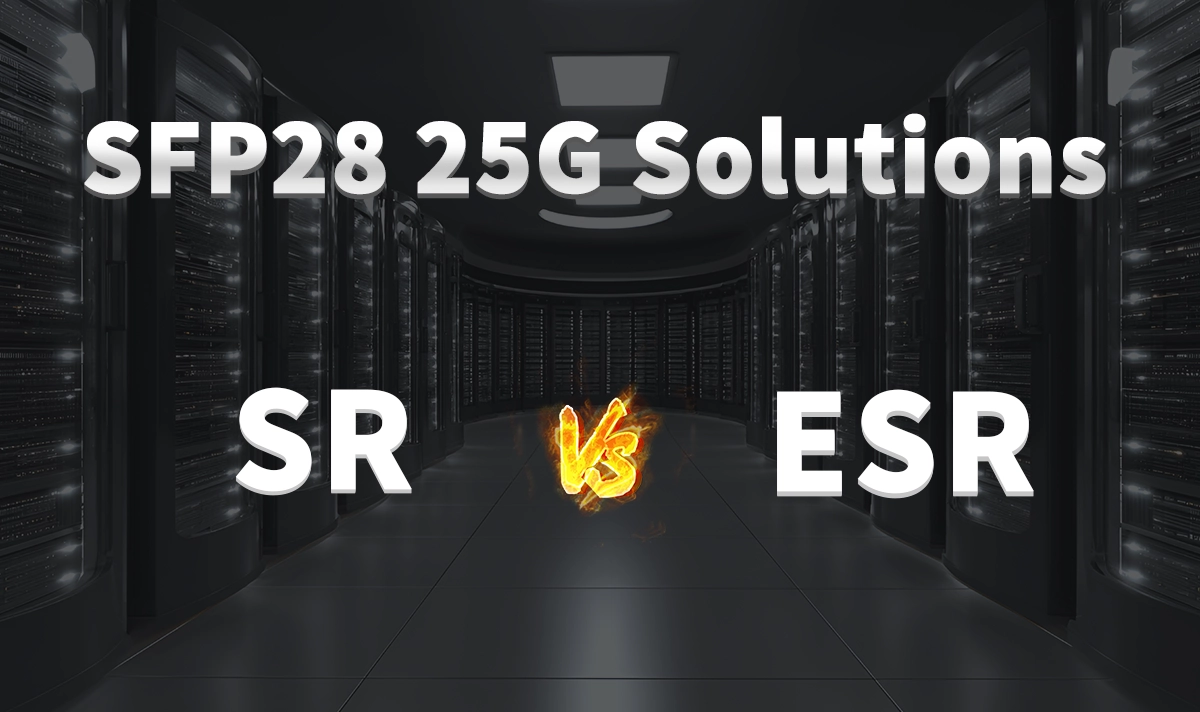
In the high-speed world of modern networking, 25GbE has become the sweet spot for top-of-rack switching, data center interconnects, and enterprise backbone links. When deploying this technology, two of the most common transceiver types you'll encounter are the SFP28-25G-SR and the SFP28-25G-ESR. While they might seem similar at a glance, understanding their differences is key to optimizing your network's performance and cost-efficiency.
This guide will provide a professional comparison to clear up any confusion.
➤ Understanding the Basics: SR vs. ESR
Both modules are designed for short-range communication over multimode fiber (MMF), using a wavelength of 850nm. The core distinction lies in their reach and the underlying technology that enables it.
SFP28-25G-SR (Short Reach): This is the standard workhorse for short-distance connections. It is designed for reaches up to 100 meters on OM4 fiber.
SFP28-25G-ESR (Extended Short Reach): As the name suggests, this module pushes the boundaries further. It leverages more sophisticated optics to achieve an extended reach of up to 400 meters on OM4 fiber.
➤ Head-to-Head Comparison: Key Differences
Let's dive into the technical specifics. The following table outlines the critical differences between these two 25G SFP28 transceivers.
Feature | SFP28-25G-SR | SFP28-25G-ESR |
|---|---|---|
Full Name | Short Reach | Extended Short Reach |
Standard Reach | Up to 70m on OM3 / 100m on OM4 | Up to 300m on OM3 / 400m on OM4 |
Fiber Type | Multimode Fiber (OM3, OM4) | Multimode Fiber (OM3, OM4) |
Wavelength | 850nm | 850nm |
Max Power Consumption | Typically < 1.0W | Slightly higher, ~1.2W |
Application | Short links within a rack or between adjacent racks | Longer intra-data center links, campus backbones |
Cost | ✅ Lower (Industry Standard) | ⚡ Higher (Extended Performance) |
➤ Choosing the Right Module for Your Application
Your choice isn't just about distance; it's about use case.
Choose SFP28-25G-SR if:
You are connecting servers to a top-of-rack (ToR) switch within the same rack.
Your link distances are well under 100 meters.
Your priority is achieving the lowest possible cost per port for standard short-reach applications.
Choose SFP28-25G-ESR if:
You need to cover longer distances within a data center hall or between buildings on a campus network without upgrading to single-mode fiber.
Your links are between 100m and 400m.
You value the flexibility to cover longer runs and avoid the cost of installing new single-mode fiber infrastructure.
For those seeking high-quality, compatible optics that deliver on their specifications, the LINK-PP LS-MM8525-S1C and LINK-PP LS-MM8525-S3C modules are engineered for maximum performance and reliability. They are rigorously tested for compatibility with major OEM switches from Cisco, Arista, Juniper, and others, ensuring a seamless integration into your existing network infrastructure.
➤ Conclusion and Next Steps
There is no "better" module—only the right module for your specific needs. The SFP28-25G-SR offers a cost-effective solution for the majority of short-reach applications, while the SFP28-25G-ESR provides the essential extra reach for more demanding network designs.

Still unsure which 25G transceiver is the perfect fit for your network topology?
Our experts at LINK-PP are here to help. We provide free consultation and lifetime warranties on all our optical transceivers.
➡️ Browse our complete catalog of SFP28 modules and get a quote today!
➤ Frequently Asked Questions (FAQ)
Q1: Can I use an ESR module for a very short link (e.g., 10 meters)?
A: Yes, you technically can. SFP28-25G-ESR modules are backward compatible with shorter distances. However, it is not cost-effective. You would be spending more on the ESR module without utilizing its key feature (extended reach). The SR variant is the optimal and economical choice for short links.
Q2: Are these modules compatible with my existing Cisco/Juniper/Arista switch?
A: Most third-party modules, including those from LINK-PP, are designed to be MSA (Multi-Source Agreement) compliant. This ensures broad interoperability. However, it is always critical to choose a reputable supplier that performs rigorous compatibility testing to avoid any issues. All LINK-PP transceivers are pre-programmed and tested for full compatibility with major brands.
Q3: Can I use OM5 fiber with these transceivers?
A: Yes! Both SR and ESR modules are fully compatible with OM5 fiber. OM5 is designed to be backward compatible with OM4. You can expect the same reach performance on OM5 as you would on OM4 (100m for SR, 400m for ESR). OM5's main advantage is for wider spectrum applications like SWDM.
Q4: What is the difference between ESR and LR? Why not always use LR for long distance?
A: SFP28-25G-LR (Long Reach) uses a single-mode fiber (SMF) and a 1310nm laser to achieve distances up to 10km. The key difference is the fiber type. ESR allows you to leverage your existing multimode fiber infrastructure for distances up to 400m. Switching to LR requires a more expensive single-mode fiber cabling system, which has a higher initial installation cost. ESR provides a perfect cost-saving solution for intermediate distances.
Q5: Do ESR modules generate more heat or consume more power?
A: Generally, yes. The extended reach capability of the ESR module requires higher laser output power, which typically results in a slightly higher power consumption (and thus, heat dissipation) compared to the SR variant. However, the difference is usually marginal (e.g., 1.0W vs. 1.2W) and is well within the thermal design limits of modern switches.




